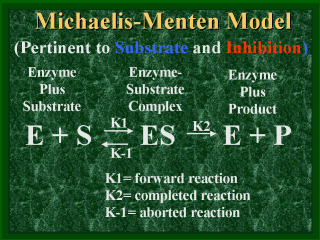 |
CYP enzymes bind medications
(ie: substrates). Recalling regular biochemistry, the reaction can proceed and the enzyme
releases the product (usually an inactivated metabolite). The likelihood for the reaction
to go to completion is described by a coefficient Km. Sometimes an enzyme has such a high
affinity for a substrate that it binds strongly to the substrate and is reluctant to let
it go. This is described by the coefficient Ki (the lower the coefficient, the more likely
it is to inhibit the enzyme). Enzymes with a low Ki for a substrate are considered
inhibitors. Sometimes the enzyme releases the substrate without completing the reaction
(K-1). Some substrates will bind an enzyme more strongly than other substrates. This is
termed competitive inhibition. Finally, some medications induce new transcription of new
enzymes. This process typically takes a few days |
